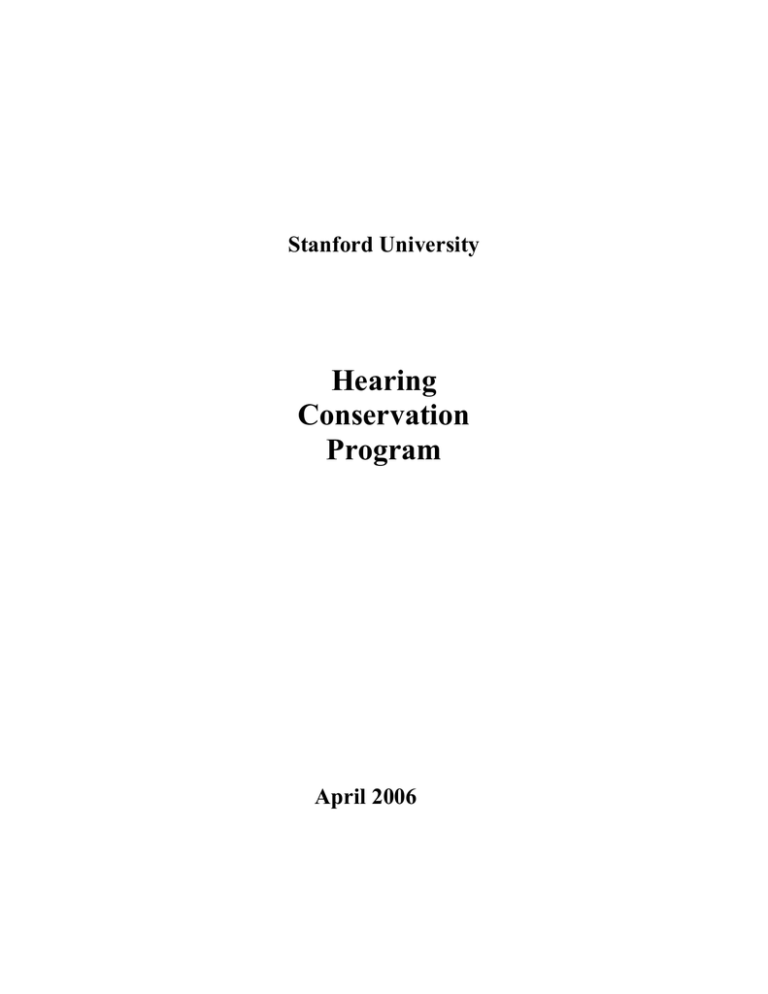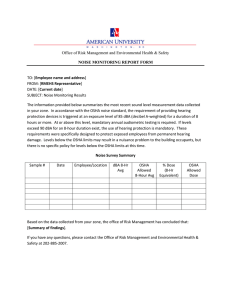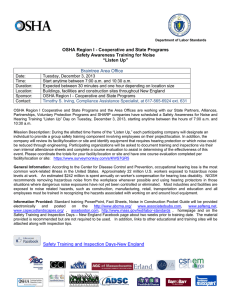Hearing Conservation Program
advertisement

Stanford University Hearing Conservation Program April 2006 Stanford University HEARING CONSERVATION PROGRAM CONTENTS 1.0 2.0 3.0 4.0 PAGE INTRODUCTION..............................................................................................1 1.1 Program Description................................................................................1 1.2 Scope........................................................................................................1 DEFINITIONS AND ACRONYMS..................................................................2 RESPONSIBILITIES.........................................................................................3 3.1 Supervisor/Department ............................................................................3 3.2 Environmental Health and Safety (EH&S)..............................................4 3.3 Employees................................................................................................4 3.4 Stanford University Occupational Health Provider.................................4 3.5 Stanford University Risk Management ...................................................5 PROGRAM COMPONENTS ............................................................................5 4.1 Noise Surveys/Monitoring.......................................................................5 4.2 Audiometric Testing ................................................................................5 4.3 Hearing Protection ...................................................................................6 4.4 Employee Education and Training ..........................................................6 4.5 Record Keeping .......................................................................................6 HEARING CONSERVATION PROGRAM 1.0 INTRODUCTION "It is the policy of Stanford University to maintain a safe and healthy work environment. Managers and supervisors are responsible for the establishment and maintenance of good 1 2 health and safety practices". The California OSHA regulation requires employers to provide employees with proper protection against the effects of noise exposure when sound levels exceed an 8-hour time weighted average (TWA) of 90 dBA (Permissible Exposure Level). The protective measures may be provided either through engineering or administrative controls. If these control measures fail to reduce the noise within the acceptable limits, personal protective equipment shall be provided and used. Additionally, whenever employee noise exposures equal or exceed an 8-hour (TWA) sound level of 85 dBA (action level), the employer shall develop and administer a Hearing Conservation Program. Requirements outlined in this manual are mandatory by regulation where the word "shall" is used and are advisory in nature where the word "should" is used. 1.1 Program Description The objective of the Stanford Hearing Conservation Program (HCP) is to prevent permanent noise induced hearing loss resulting from on-the-job noise exposure and to comply with Title 8 of the California Code of Regulations, Sections 5095-5100. Stanford University's Hearing Conservation Program includes: • • • • • Noise surveys Audiometric Testing Hearing protection Employee education and training Record keeping 1.2 Scope This Hearing Conservation Program applies to all employees of Stanford who are determined to equal or exceed the Action Level established by CAL/OSHA. 2.0 DEFINITIONS AND ACRONYMS 1 Stanford University Administrative Guide Memo 25.5 2 Title 8, Article 105, section 5095-5100 of California Code of Regulations. Action Level: An 8-hour time-weighted average of 85 decibels A-weighted (85 dbA 8-hr TWA) established by CAL/OSHA. Administrative Controls: Methods that limit an employee’s exposure time to noise. This includes assigning the employee to less noisy areas in the workplace for a certain length of time so the employee shall not exceed the action level. Audiogram Testing: Exams that measure the sensitivity of a person's hearing threshold in decibels as a function of frequency. Audiometer: An instrument for measuring the threshold or sensitivity of hearing. Audiologist: A professional specializing in the study and rehabilitation of hearing, who is certified by the American Speech-Language-Hearing Association or licensed by a state board of examiners. Baseline Audiogram: An audiogram obtained after 14 hours of quiet. The audiogram against which future audiograms are compared. Continuous Noise: Noise levels that vary with intervals of one second or less. Decibels (dB): A measure of the sound level (loudness). The decibel scale is a logarithmic scale; as an example, a 90 dB noise is ten times louder than a 80 dB noise. Decibels, A-Weighted (dBA): The A weighted is the scale used for most occupational noise measurements. The A weighting approximates the range of human hearing by reducing the effects of lower and higher frequency noises with respect to the medium frequencies. Decibels, C-Weighted (dBC): The C weighted scale filters include both high and low frequency noise and are used for impact noise and in the selection of hearing protection. Engineering Controls: May include purchasing quieter equipment using barriers, damping, isolating, muffling, installing noise adsorption material, mechanical isolation, variations in force, pressure or driving speed or any combination of methods to decrease noise levels. Frequency: A sound's pitch measured in hertz (hz); high pitches are high frequency sounds. Hearing Conservation Program (HCP): Program established when employees are exposed to noise exceeding the Action Level. Program must include noise surveys, audiometric testing, hearing protectors, training, and recordkeeping requirements. Hearing Protection Devices (HPD's): Personal protective equipment that is designed to be worn in the ear canal or over the ear to reduce the sound level reaching the ear drum. Examples include ear muffs or plugs. Hearing Threshold Level (HTL): The lowest threshold that the employee can hear the test tone during an audiometric test. The HTL's are recorded on the employee's audiogram. Hertz (Hz): A unit of measurement of frequency, expressed as cycles per second. Impulse/Impact Noise: Noise that is a sharp burst of sound, generally less than one-half second in duration, that does not repeat itself more than once per second. Noise: Unwanted sound. Noise Dosimeter: An instrument worn by an individual that integrates the sound level exposure over a period of time. Noise Reduction Rating (NRR): The Noise Reduction Rating of hearing protection devices (HPD) indicates the theoretical amount of reduction of noise levels that can be achieved if the HPD is worn correctly. This rating is shown on the HPD packaging. Otolaryngologist: A physician specializing in diagnosis and treatment of disorders of the ear, nose and throat. Permissible Exposure Limit (PEL): 90 dBA 8-hr TWA. Pitch: Another term for sound frequency. Higher pitches are higher frequency sounds. Representative Exposure: Measurements of an employee's noise dose or 8-hour time weighted average sound level that is representative of the exposures of other employees in the workplace. Sound: A vibration or pressure oscillation that is detectable by the ear drum. Sound Level Meter : An instrument used for the measurement of noise in sound level surveys. Speech Interference Levels (SILs): The frequencies most associated with speech, which are the 5004000 hz (frequency) range. Vowels (a, e, i, o, u) are low frequency sounds (below 2000 hz) and consonants (b, c, d, etc) are high frequency sounds. The low frequencies are the least affected by noise. If the high frequencies are affected, t's and p's or s's and f's may be easily confused. Standard Threshold Shift (STS): An average shift from the baseline measurement in either ear of 10 dB or more at 2000, 3000 and 4000 Hz. These frequencies are the most important frequencies in communication and the most sensitive to damage by industrial noise exposure. See Section 3.5 Stanford Risk Management for a definition of a CAL-OSHA reportable STS. Time-Weighted Average Sound Level (8-hr TWA): That sound level, which if constant over an 8hour exposure, would result in the same noise dose measured in an environment where noise level varies. Threshold of Pain: A noise level of 120 dB causes pain. 3.0 RESPONSIBILITIES 3.1 Supervisor/Department • • • • Notifying Environmental Health and Safety (EH&S) of noise complaints or potential noise hazards. Ensuring that employees are provided with hearing protectors when required. Ensuring that employees properly use and care for hearing protectors. Ensuring that noise-hazardous equipment/areas are properly labeled or posted (greater than or equal to 85 dBA operating noise level). • • • • • • 3.2 Notifying Environmental Health and Safety (EH&S) of process, materials or equipment changes that may alter noise exposures. Ensuring that potentially overexposed employees are provided with a baseline audiometric hearing test prior to the initial work assignment and then annually thereafter. High noise exposure must be avoided for 14 hours prior to an exam. Enforcing the use of hearing protectors or noise reduction procedures in the designated areas/assignments. Ensuring new employee HCP orientation/training and annual refresher HCP training of employees are provided to all potentially overexposed personnel. Post copy of occupational noise regulation (California Code of Regulation, Title 8, Sections 5096-5100, Article 105) Maintaining the following records (see Record Keeping 4.5): --Name and job classification of the employee in the HCP --Audiometric test results from our Occupational Health Provider --Noise exposure assessments from EH&S --Training documentation Environmental Health and Safety (EH&S) • • • • • 3.3 Administering the Hearing Conservation Program. Workplace and employee noise evaluation: -- noise assessment to determine if administrative and engineering controls are needed, and how they should be implemented. -- identification of areas or processes that require noise abatement and/or posting. -- evaluation and periodic re-evaluation of employees' exposure, by job classification, to determine which job titles need to be included in the Hearing Conservation Program. Maintaining records of employee exposure measurements. Provideing comprehensive annual training on HCP and HPDs. Assist employees in selecting the proper HPDs and provide instruction on their use. Employees • • • • 3.4 Wearing hearing protection devices and following any noise reduction procedures as required. Storing and maintaining HPDs in a clean and sanitary manner. Reporting noise hazards and hearing protector problems to their supervisor. Attending required training sessions on HCP. Stanford University Occupational Health Provider • • • • Providing baseline, annual, and post-employment audiometric testing. Performing audiogram evaluations. Communicate any identified work-related (or aggravated by occupational noise exposure) standard threshold shifts to the employee, his/her supervisor, EH&S, and Risk Management (if reportable under Title 8 CCR 14300.10). Maintaining audiometric test records. • 3.5 Stanford University Risk Mangement • 4.0 Recommending appropriate hearing protectors and fitting as needed. Shall record cases of occupational hearing loss if the current employee’s current audiogram reveals a work-related Standard Threshold Shift (STS) of 25 decibels or more (averaged at 2000, 3000, and 4000 Hz) above audiometric zero in the same ear on the Cal/OSHA Form 300 (or equivalent). [Title 8 CCR 14300.10] PROGRAM COMPONENTS 4.1 Noise Surveys/Monitoring • • • • • 4.2 Audiometric Testing • • • • • • 4.3 Representative noise monitoring with a designed sampling strategy will be performed by Environmental Health and Safety to allow the identification of employees for inclusion in the Hearing Conservation Program and to enable the proper selection of hearing protection. All continuous, intermittent and impulsive sound levels from 80 to 130 dBA shall be integrated into the computation of an 8-hr TWA. Monitoring shall be repeated when any changes occur in production, process, equipment or controls which might render the hearing protectors inadequate or require additional employees to be included in the program. Employees exposed at or above the action level shall be notified of the results of the monitoring. Employees' noise exposure shall be reassessed periodically as needed (i.e. following changes in processes, job responsibilities, equipment or when a STS is determined). Audiometric testing program shall be managed by our Occupational Health Provider. Performing audiometric database analysis (ADBA) procedures, as defined in ANSI Standard S12.13-1991, to assess the effectiveness of hearing conservation efforts (i.e., is hearing loss being prevented). Baseline audiograms shall be preceded by at least 14 hours without exposure to workplace noise. This requirement may be met by wearing hearing protectors which will reduce the employee's exposure to a sound level of 80 dBA or below. Baseline audiograms shall be provided for the employees whose job classification are included in the Hearing Conservation Program upon employment, and annually thereafter. Evaluation of audiograms shall be done in compliance with CCR Title 8, section 5097(d). Employees shall be informed in writing within 21 days when an audiogram indicates a standard threshold shift which is determined to be work related. Hearing Protection Devices • • • • • • • • • 4.4 Employees exposed to noise levels at or above an 8-hour TWA of 90 dBA shall wear hearing protectors. Employees exposed to noise levels at or above the action level of an 8-hour TWA of 85 dBA shall wear hearing protectors if they have experienced a documented standard threshold shift or have not obtained a baseline audiogram. Hearing protectors shall be available to all employees exposed to noise levels at or above the action level of 85 dBA, 8-hr TWA, at no cost to the employees. Employees shall be given the opportunity to select their hearing protectors from a variety of suitable types. Proper initial fitting and supervision of the correct use of hearing protectors shall be provided. Hearing protector attenuation shall be evaluated for the specific noise environments in which the protector will be used. The methods used for measuring attenuation shall be one of the four methods described in CCR Title 8, Section 5098, Appendix E. Hearing protectors must attenuate the noise level to an 8-hour TWA of 90 dBA or less. For employees who have experienced a standard threshold shift, the attenuation must reduce the sound level to an 8-hour TWA of 85 dBA or less. Re-evaluation of hearing protectors shall be done whenever a workplace noise level increase renders the hearing protector's attenuation inadequate. Workplaces in which the noise level exceeds 85 dBA shall have signs posted. Signs shall read "Hearing Protectors Required". Employee Education and Training • • • • 4.5 Annual training is required for all employees exposed to noise at or above an 8hour TWA of 85 dBA. The training shall cover the following information: -- the effects of noise on hearing. -- the purpose, advantages, disadvantages, and attenuation of various types of hearing protectors. -- instruction of proper fitting and care of protectors. -- the purpose and procedures of audiometric testing. Copies of the occupational noise regulation (CCR Title 8, Section 5096-5100, Article 105) shall be available to affected employees and their representatives. A copy of the regulation shall also be posted in the workplace. Any informational materials pertaining to this standard that are supplied by OSHA shall be available to the affected employees. Record Keeping • • Noise exposure measurement records shall be retained for at least 2 years by Environmental Health and Safety. Audiometric test records provided by our Occupational Health Provider should be maintained by departments with employees enrolled in the Hearing Conservation Program and shall include : • -- the name and job classification of the employee -- the date of the audiogram -- the examiner's name -- the employee's most recent noise exposure assessment -- the date of the last acoustic or exhaustive calibration of the audiometer and the measurement of the background sound pressure levels in the audiometric test rooms. Records of audiometric test results shall be retained for the duration of the affected employee's employment. Record Location Retention Time Medical Evaluations and Audiograms Medical Evaluation Results Hearing Conservation Program Manual Noise Surveys and Employee Noise Monitoring Training Records Occupational Health Provider As long as employee is enrolled in HCP Supervisor/Department As long as employee is enrolled in HCP On-going EH&S and website EH&S and/or Supervisor/Department At least 2 years Supervisor and/or Department At least 2 years




